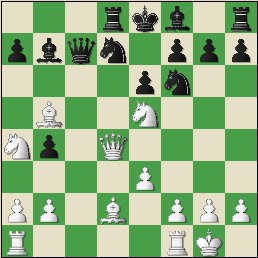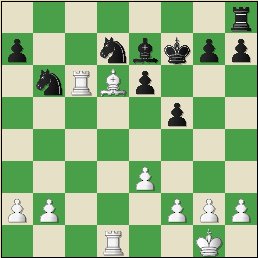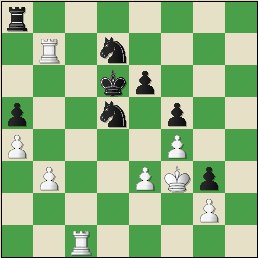Kramnik, possibly exausted from three Blacks in a row, capitulated to a nearly perfectly played, unbalanced position by Topalov. As Susan Polgar put it so well in her blog, I paraphrase: "These kinds of positions you should play out hundreds and thousands of times. It is the only way you can understand them. That was part of my training as a young girl".
G8: Kramnik,V (2743) - Topalov,V (2813)
WCh Elista RUS (8), 05.10.2006
[IM Malcolm Pein]
(Thanks to Mark Crowther,
The Week In Chess, and Malcolm Pein for commentary and analysis)
1.d4 d5 2.c4 c6 3.Nf3 Nf6 4.Nc3 e6 5.e3 Nbd7 6.Bd3 dxc4 7.Bxc4 b5 So this is Topalov's surprise, its a line Kramnik also plays with Black 8.Be2 Bb7 9.0-0 b4 10.Na4 c5!? Sharper than the standard 10... Be7 Topalov's pre-match preparation emerges. 11.dxc5 Nxc5 12.Bb5+ Ncd7 13.Ne5 Qc7 14.Qd4 [ 14.Nxd7 Nxd7 15.e4 ( 15.b3 Bd6 16.Bb2 Rd8 17.h3 0-0 18.Rc1 Qb8 19.Bxd7 Rxd7 20.Qg4 f5 21.Qg5 Qd8 22.Qxd8 Rfxd8 23.Nc5 Bxc5 24.Rxc5 Rd2 25.Bd4 Rd7 26.Rfc1 Rxa2 27.Rc7 Rxc7 28.Rxc7 Bd5 29.Rxg7+ Kf8 30.Rxa7 Rxa7 31.Bxa7 Bxb3 32.Bc5+ Kf7 33.Bxb4 Bd5 34.f3 1/2-1/2 Taborska,V-Hasek,V (2154)/Czechia 1999) 15...Rd8 16.Bg5 f6 17.Be3 Qe5 18.Qe2 Bd6 19.f4 Qxe4 20.Rad1 a6 21.Bc4 Bb8 22.f5 Qe5 23.Qh5+ g6 24.Qh3 Bxg2 25.Qxg2 Qxe3+ 26.Kh1 Ne5 27.Rxd8+ Kxd8 28.Qb7 Bd6 29.fxe6 f5 30.e7+ Ke8 31.Qc8+ Kxe7 32.Qe6+ Kf8 33.Qf6+ Ke8 34.Qxh8+ Kd7 35.Qxh7+ Kc6 36.Qg8 Qe4+ 37.Kg1 Qg4+ 1/2-1/2 Shinkevich,V (2440)-Somkin,E (2309)/Bor 2000/EXT 2001] 14...Rd8! [ 14...Bd6 15.Nxd7 Nxd7 16.Rd1 Ke7 17.Bxd7 Rad8 18.Bd2 Rxd7 19.Bxb4 Rhd8 20.Rac1 Qb8 21.Nc3 f6 22.Bxd6+ Rxd6 23.Qc5 Kf7 24.Rxd6 Qxd6 25.Qxd6 Rxd6 26.Rd1 Ke7 27.Rxd6 Kxd6 28.f3 Kc5 29.Kf2 Ba6 30.Ke1 Bd3 31.Kd2 Bg6 32.Ne2 Bb1 33.Nc3 Bg6 34.Ne2 Kc4 35.Nd4 Bf7 36.b3+ Kb4 37.Nc2+ Kc5 38.a4 a5 39.Kc3 e5 40.Na3 Be6 41.Nc2 Bc8 42.b4+ axb4+ 43.Nxb4 Kb6 44.Nd3 Ba6 45.g3 Bb7 46.f4 exf4 47.Nxf4 Kc5 48.Ne6+ Kd5 49.Nxg7 Bc6 50.a5 Ke4 51.Nh5 f5 52.Kd2 Kf3 53.Ng7 Kg2 54.Nxf5 Kxh2 55.Kd3 Kh3 56.Kd4 Kg4 57.e4 Kf3 58.e5 Kg4 59.Kc5 1-0 Avdeenko,V-Novikov,I (2370)/Rostov on Don 1980; 14...Rd8] 15.Bd2 Diagram

|
[ White may have gained a tempo with Bb5+ but his Na4 is very bad and taking on a7 would not be advisable after 15.Qxa7 Bd6 16.f4 0-0 when the White queen and knight are both badly placed.]
15...Qa5N [ 15...a6 16.Rfc1 Qa5 17.Bc6 Bxc6 18.Nxc6 Qxa4 19.Nxd8 Kxd8 20.a3 Qb5 21.axb4 Nd5 22.Ra5 Qb6 23.Qc4 Nc7 24.Bc3 f6 25.Bd4 Qb7 26.b5 Nxb5 27.Qxe6 Nxd4 28.exd4 Bb4 29.Rxa6 Re8 30.Qa2 Bd2 31.Rf1 Bf4 32.g3 Bb8 33.Re6 Rxe6 34.Qxe6 Qxb2 35.Qg8+ Kc7 36.Qxg7 Ba7 37.Qxh7 Bxd4 38.Qf5 Qd2 39.h4 Nc5 40.Qh7+ Kd6 41.Qh5 Ne4 42.Qf3 Ke5 1/2-1/2 Cvetkovic,S-Bagirov,V/Vrnjacka Banja 1974]
16.Bc6 Be7! This is the idea
17.Rfc1 We are going to get a material imbalance so Topalov must be pleased and he was moving fast as usual
[ 17.Bxb7 Nxe5 wins as a4 and d2 hang]
17...Bxc6 18.Nxc6 Qxa4 19.Nxd8 [ 19.Nxe7 was extremely risky but both Kramnik and Topalov seemed to suggest this could be played.]
19...Bxd8 20.Qxb4 Of course Kramnik gets the queens off but Black can probably unravel. Either way we are
[ 20.Bxb4 a5 21.Bc5 Qxd4 22.Bxd4 e5 23.Bc3 Bb6 looks very comfortable for Black]
20...Qxb4 21.Bxb4 Nd5! After the game Kramnik said he'd missed this move and black's next when committing to this variation.
22.Bd6 f5 to play Kf7 and gradually get the rook into play. In the absence of any obvious targets for the white rooks and no imminent passed pawn Black must be OK.
23.Rc8 N5b6 24.Rc6 Be7 [ 24...Bf6 25.Rac1 Bxb2 26.Rc8+ Kf7 27.Rxh8 Bxc1 28.Rxh7 Looks good for Black, a2 may be loose]
25.Rd1 Kf7 Diagram
26.Rc7 Kramnik succeeds in preventing any activity for the moment. It was interesting to note while watching this game online how the stronger the spectator the more they liked Black's long term chances because any change in the pawn structure on the kingside tends to create better squares for the Black knights.
[ 26.Bxe7 Kxe7 27.Rdd6 Nb8 28.Rxe6+ Kf7! 29.Rxb6 axb6 30.Rxb6 was suggested by Kramnik as offering decent drawing chances for white.]
26...Ra8! Keeping rooks on.
27.Rb7 Ke8 28.Bxe7 Kxe7 29.Rc1 [ 29.f3]
29...a5 30.Rc6 Nd5 Black has totally unravelled and can look to expand on the kingside. Kramnik has been unable to find an active plan. Perhaps he should have centralised his king quicker.
31.h4 h6 32.a4 Fixing the a5 pawn but making the a pawn slightly more vulnerable. At some point the black rook might leave a8 to get active and then this pawn is one move closer topromotion
32...g5! A far sighted plan, Black gains space and prepares to move his knights forward.
33.hxg5 hxg5 34.Kf1 Ke2 and f2-f3 is a plan
34...g4 Now f3 can be met by g3 and a Black knight might usefully come to e4
35.Ke2 N5f6 36.b3 Ne8! Coming to d6 and forcing a white rook off the b file.
37.f3? [ 37.Rc1 Nd6 38.Rbc7 Ne4]
37...g3! Of course Topalov wants to keep pawns on but this pawn may provoke a crisis, in order to attack it Kramnik must make a concession elsewhere for example by removing the Rc6 from the queenside. Then the black king couldroam
38.Rc1 Nef6 39.f4 To attack the pawn but White is getting stretched here. Black can unpin the Nd7 and play Ne4. If he could get knights on e4 and d5 a 'levelling' of the score would be on the cards
39...Kd6 40.Kf3 Nd5! Diagram
Black has another active possibility e6-e5
41.Kxg3? This seems to be very very bad after Nc5 see the following line
[ 41.Rb5 e5 42.Kxg3 Nxe3 43.fxe5+ Nxe5 44.Rh1 Rg8+ White could get mated if he is not careful but Kramnik is pretty careful most of the time 45.Kf4 Nxg2+ 46.Kxf5]
41...Nc5! Suddenly its over the knights spring into action.
42.Rg7 [ 42.Rb5 Ne4+ 43.Kf3 Rg8 44.Rxa5 Rg3+ 45.Ke2 Rxe3+ 46.Kf1 Rxb3]
42...Rb8 43.Ra7 Rg8+ 44.Kf3 Ne4 45.Ra6+ Ke7 46.Rxa5 Rg3+ Two rooks and a knight can deliver mate.
47.Ke2 Rxe3+ 48.Kf1 Rxb3 49.Ra7+ Kf6 50.Ra8 Nxf4 51.Ra1 Rb2 52.a5 Rf2+ 0-1



Comments